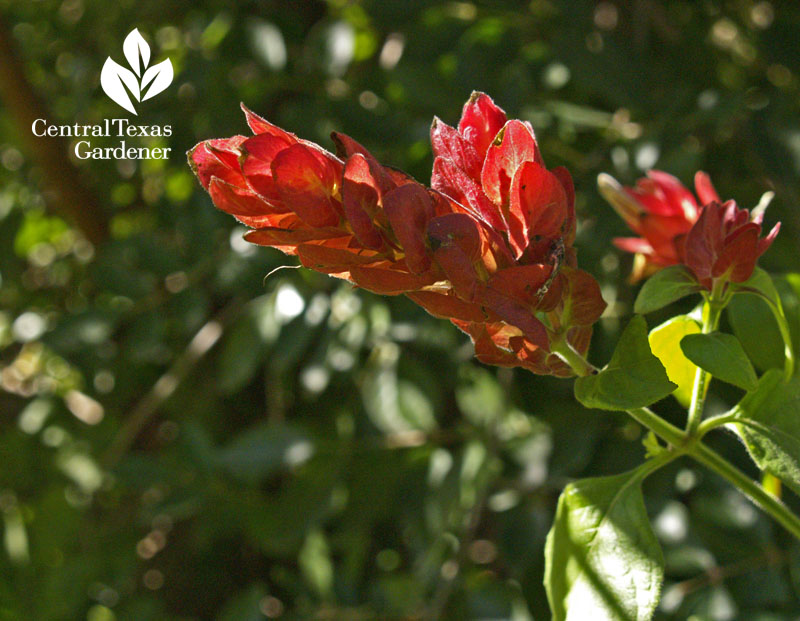January 9, 2013
Pruning prep + Fruit trees + Rooftop gardens
Christmas lights are down, but my shrimp plants glow like holiday lights all day!

That brings up the top question right now: when do we clean up and cut back? Well, I’m not cutting back that beauty just yet. I’ll take the Felcos to it in March to restore its luscious figure. With our swings from hot to freeze, we don’t want to encourage new growth on potentially tender plants like this one. I’ve never lost one to super freeze, but new growth would be fried. Our lives can get stressed, but no reason to freak out our plants!
I did cut back my hardy pink skullcaps (Scutellaria suffrutescens) that were just too woody. They won’t mind as they hurry up to cover themselves anew.

Same thing goes for Salvia greggii, even though some are trying to bloom. Do it anyway! Cutting them back several inches now will promote new growth and lots of flowers soon (since they bloom on new wood). If you let this go, you’ll end up with lots of woody branches and a disappointing view come May.

My Copper Canyon daisy (Tagetes lemmonii) just hasn’t got this figured out yet!

It’s supposed to bloom in fall, but it wimped around since my garden missed all those rains. Although it’s drought tolerant, this one was only in its second season. I gave it some deep soakings and it popped back from death row. Now, I’ll let it bloom its little head off and cut it back several inches in a few weeks. I didn’t prune last winter and that was a mistake. Pruning = powerful pretty!
Another plant we can prune sooner than later is rock rose (Pavonia lasiopetala) that is a total mess if you don’t take a firm hand.

Now, most of us know this as a pretty-in-pink perennial subshrub. But viewer Laura has one that seeded out pure white!

Daphne explains how Laura ended up with this beauty, and how she can get more of them. In a nutshell, Daphne reports that white flowers are recessive in rock rose. But sometimes through pollination, genes cross in such a way that both parents contribute the recessive white-flowering gene, instead of the pink-flowering one. Cool, huh?!
If you’ve been hankering for your own fruit trees, grapes, or blackberries, energetic Jim Kamas, Texas AgriLife Extension fruit specialist, joins Tom this week.

Find out which trees are self-pollinating or need another variety to fruit, how to promote plant health, and when to prune. Check out Texas A&M’s comprehensive Fruit & Nuts fact sheets for details on every mouth-watering one on your list!
A native fruit tree that works even as an understory is Texas persimmon (Diospyros texana), Daphne’s Pick of the Week.

Lamar Hankins and his wife are lucky to have them naturalizing on their San Marcos land.

Last year, Lamar experimented to make the perfect jelly/jam from their black fruits, which he reports tastes like blackberry jam. Here’s his yummy recipe.
Since now is when nurseries will have bare root fruit trees, grapes, and berries in stock, John Dromgoole shows you how to plant them.

Like bare root roses, which are showing up, it’s essential to put them in a bucket of water for a few hours before planting. Absolutely, do not let their roots dry out!
On tour, see how these gardeners are really on top of things with rooftop vegetables, fruits, and succulents! Contemporary architecture, architectural plants, and organic gardening come together with designer Patrick Kirwin and project architect Thomas Tornbjerg of Bercy Chen Studio.
Thanks for checking in! See you next week, Linda
tags:

